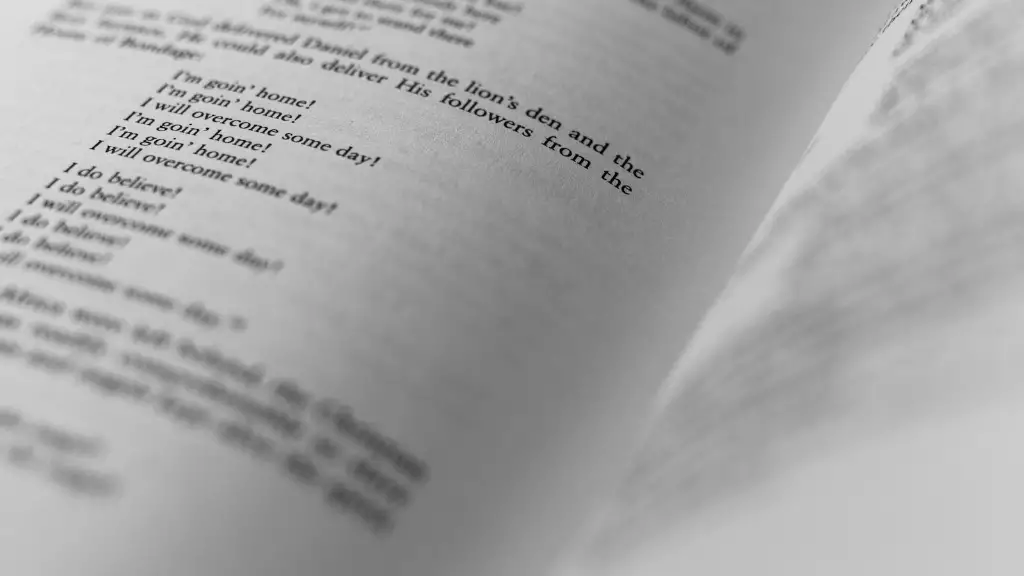Robert Frost’s use of blank verse has become iconic in literature; it provides structure, economy of words and an expressive, lyrical quality to his work. By understanding why Frost chose to write in blank verse, we can appreciate the skill and creativity behind his poetry even more. The most important reasons for Frost’s use of this form can be found in his love of form in poetry, his skill in craftsmanship and his desire to be distinct from other poets.
Frost had a great affection for poetic form and structure, which is evident in his work. He was a great believer in the power of limits, a concept that is subtly present in the blank verse structure of his poetry. By using the established and traditional form of a line of uninterrupted iambic pentameter, Frost was able to challenge himself to be creative within the confines of a restrictive form.
Frost was also highly skilled in craftsmanship, particularly when it came to writing poetry in the form of blank verse. Frost was known to be precise, precise to the point that he could create an identifiable meter, such as an iambic pentameter, using only minimal words and still achieve a precise and complex rhythm. In this way, Frost was able to use blank verse to create an aesthetic which, along with his choice of simple language, often created a powerful emotional impact.
Finally, Frost was conscious of being seen as distinct from other poets. He chose to write in blank verse as a means of creating a distinct poetic style not found in the work of other poets. He used blank verse to add a lyrical quality to his work and to separate it from other poets who used other forms of poetry.
Overall, Frost’s use of blank verse helped make him one of the most iconic poets of his time. It allowed Frost to express his ideas in an economical and precise manner, while also allowing him to rise above the crowd of other poets. To understand Robert Frost’s legacy as a poet, we must understand and appreciate why he chose to write in blank verse.
How Was Blank Verse Used In Robert Frost’s Poetry?
In order to understand how Robert Frost used blank verse in his poetry, it is important to first understand the particular characteristics of blank verse. Generally, blank verse is composed of unrhymed iambic pentameter lines, in which the rhythmic pattern of an unstressed syllable followed by a stressed syllable is repeated five times per line. In this way, blank verse combines a lyrical quality with a regularity of rhythm that gives it an almost musical quality.
Robert Frost often chose to write in blank verse because it allowed him to combine the precision of his use of language with a lyrical quality that is unique to this particular verse form. His use of blank verse is often characterized as having a simplicity and directness that vividly evokes images of nature and rural life – topics that are often explored in Frost’s poetry. He also used blank verse to structure his poems, often combining single lines of blank verse with rhymed or free verse to create an overall structure or theme within a poem.
Robert Frost’s most iconic poem, “The Road Not Taken,” employs the use of blank verse in its entirety. Frost painstakingly structured the poem to have four even stanzas, each with five lines of blank verse. By combining an even structure with the use of blank verse, Frost is able to create a sense of elemental simplicity which helps to bring the poem’s core message of individual decision-making to life.
The use of blank verse in Robert Frost’s poetry was integral to the construction of his works. By combining this particular type of verse with whimsical language and vivid imagery, Frost created a distinctive style that resonates with readers even today. This is why Robert Frost’s use of blank verse is so often praised – it enabled him to bring an added level of lyricism, structure, and precision to his poetry.
How Did Robert Frost Use Metrical Variation In His Blank Verse Poetry?
When examining Robert Frost’s blank verse poetry, it is important to note that the vast majority of the poet’s lines are composed of iambic pentameter – a five-beat, unstressed-stressed lyrical pattern. While studying Frost’s poetry, however, it is also apparent that he experimented with metrical variation by introducing lines that diverged from the traditional five-beat pattern.
One of Frost’s most common variations from the traditional iambic pentameter was the use of trochaic lines, a type of poetic meter in which the first syllable of the line is stressed. This type of metrical variation further enhanced the lyrical quality of Frost’s work, while also highlighting the sophisticated craftsmanship behind his writing. In the first line of “The Road Not Taken” for instance, Frost uses a repeating and subtle trochaic pattern to create a sense of hesitation, which encapsulates the poem’s key theme of individual choice and decision making.
Also, Frost often employed enjambment, a technique by which a sentence or thought continues over multiple lines of blank verse without grammatical completion. Enjambment was often used to create a sense of momentum within a line or stanza, or to add an unexpected level of expressiveness to poems. For example, in the second stanza of ‘Mending Wall’, Frost uses the technique of enjambment to create an unexpected ending to the thought: ‘We have to use a spell to make them balance: / ‘Spring is the mischief in me’, I finished the thought in my head’. By not finishing the thought in the first line, Frost creates an impression of thought itself as an unending process – a notion which perfectly encapsulates the poem’s central idea of change and renewal.
Through his use of metrical variation, Robert Frost artfully used blank verse to manipulate the lyrical quality of his work. By using techniques such as trochaic meter, Frost was able to create more complex rhythms, while enjambment enabled him to express thoughts, emotions and images more fully. In this way, Frost was able to use metrical variation to convey beauty and complexity in a simply structured form.
How Does Frost’s Use of Blank Verse Emphasize the Themes of His Poetry?
Robert Frost’s use of blank verse serves to emphasize the underlying themes of his stories, providing a framework for exploring ideas, emotions and imagery. By adhering to the strict limits of this form, Frost was able to construct subtle and symbolic meanings, expressing ideas that are often central to the poem’s overall theme.
One of the most prevalent themes in Frost’s poetry is that of human mortality, and this theme is often explored in his blank verse poetry. For example, in Frost’s poem ‘Fire and Ice’, Frost uses the strict iambic pentameter of blank verse to emphasize the finality of mortality. The use of a repeating five-beat pattern symbolically suggests the inevitability of death, while the words of the poem express a sense of resolution and acceptance of one’s mortality: ‘So…with a different judgment, I/ Have…diverged from those who see the fate’.
The simplicity of the blank verse form is also used to convey the themes explored in Frost’s poetry. By using simple, short sentences, Frost was able to create a sense of immediacy and intensity which quickly drew the reader into the narrative. This allows Frost to explore complex and meaningful themes, such as human relationships, nature, and life itself. For example, in ‘Stopping By Woods On A Snowy Evening’, Frost uses the starkly direct blank verse to express the earnest and sincere nature of the poem’s primary theme – the need to savor the moment and take in the beauty of nature: ‘The woods are lovely, dark and deep/ But I have promises to keep’.
Frost’s use of blank verse also allowed him to explore complex themes which could not be expressed in a more traditional narrative poem. Frost often used short lines of blank verse to express ideas that were difficult to express in any other form. In ‘Mending Wall’, for example, Frost uses blank verse to evoke a sense of elemental understanding which defies the traditional linguistic categories of thought: ‘Something there is that doesn’t love a wall/ That wants it down’.
By understanding Robert Frost’s use of blank verse, the subtleties and depths of his poetry are further illuminated. By adhering to the strict iambic pentameter of blank verse, Frost was able to convey ideas that could not be expressed through traditional poetry. He was able to explore themes of mortality, relationships and human nature in a direct, lyrical way. This is why Robert Frost’s use of blank verse became so iconic in literature – it provided him with a structure to communicate the essential truths of life.
What Are the Benefits of Reading Robert Frost’s Blank Verse?
The use of blank verse by Robert Frost has made him one of the most studied and appreciated poets of all time. Reading Frost’s blank verse poetry is an incredibly rewarding experience, as it reveals the subtle craftsmanship and creativity which lies beneath the surface of the poet’s work.
The greatest benefit of reading Frost’s blank verse is the ability to appreciate the beauty and complexity which lies beneath the simple rhyme scheme of a line of iambic pentameter. By studying Frost’s work, readers can gain an appreciation for the subtlety and technical skill which lay within a line of blank verse.
Frost’s use of blank verse further allows readers to access the emotional power behind his words. By using an iambic pentameter, Frost is able to highlight the emotion which lies beneath the surface of his words. There is also a unique expressiveness to Frost’s words; by using simple language, Frost is able to evoke powerful feelings and create vivid images.
Finally, understanding the use of blank verse in Frost’s poetry allows readers to better appreciate the depth and substance of the poet’s work. By combining the intricate and lyrical structure of blank verse with the simple language and careful symbolism of Frost’s poetry, readers can gain access to the deeper meanings of Frost’s work.
In short, reading Robert Frost’s blank verse is a rewarding experience for readers as it grants them access to Frost’s skill as a craftsman and his ability to convey powerful emotion and symbolism. By appreciating the structure and underlying meanings of Frost’s blank verse poetry, readers can gain a greater understanding of the poet’s work and its timelessness.
How Did Frost Use Imagery In His Blank Verse Poetry?
When examining Robert Frost’s work, it is clear that the use of imagery was an integral part of the poet’s creative style. Frost was highly skilled at combining images of the natural world with vivid and abstract language, allowing him to explore themes of mortality, mortality and human nature without getting bogged down in the details. A great example of this is Frost’s use of imagery in his blank verse poetry.
Frost was able to use the blank verse form to add a lyrical quality to his imagery and give it a sense of structure. He often used simple and concise descriptions of nature to bring out deep and meaningful emotions, often to demonstrate the passing of time or reflect on the universal nature of existence. In poems such as “Stopping By Woods On A Snowy Evening”, Frost uses a simple sentence, ‘The woods are lovely, dark and deep’, to convey an intense sense of peaceful contemplation.
The use of imagery by Frost was not limited to descriptions of nature. He also used imagery to add vivid details to the characters and stories he explored in his work. In “Mending Wall”, for example, Frost describes





